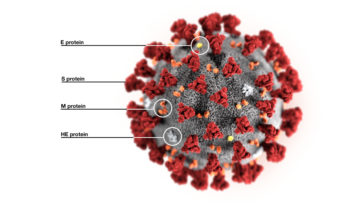Social distancing effects on laboratory operations
Our institution is a multicampus university teaching hospital with over 2,150 beds. Strict social distancing requirements have imposed limitations on staff and workflows in all workspaces. Where possible, clinical and laboratory staff have been separated, and working from home encouraged. All laboratory staff now work in discrete teams without crossover, so that if members of one team became unwell, the laboratory would still be adequately staffed. Scientific staff either commence work earlier (6am) or finish later (11:30pm), affecting sleep patterns and family time, including time available for care of quarantined children. Splitting of shifts has required utmost attention to communication, with clear handover processes to ensure tasks are not missed.
Expanded use of technology including digital pathology has necessitated purchase and deployment of additional equipment for home use.
In the microbiology laboratory, using every second bench ensures distances are maintained. Laboratory workspaces are separated, so that, for example, molecular scientists do not interact with bacteriology scientists during shifts. Additional changes reinforce hand hygiene (lunch room doors propped open, increased fixed alcohol hand rub availability) and breaks staggered to accommodate maximum allowable staff in rooms at any one time. Extra break rooms and dedicated outdoor spaces are available.
Microscope cameras and virtual meetings/screen sharing are used for reporting, such as morphology and flow cytometry. Expanded use of technology including digital pathology has necessitated purchase and deployment of additional equipment for home use.
Review of personal protective equipment requirements meant that some processes newly required use of masks, gowns, goggles and processing in biological safety cabinets. For example, molecular staff are now required to wear N95 masks to process respiratory specimens, and therefore training in donning and doffing of these masks was required.
Specimen collection, processing and reporting
Some specimen collection centres were closed and consolidated to other sites, resulting in disruption for staff and patients. Non-urgent sample collections were reviewed and postponed where possible. At the same time, three new patient screening clinics and three staff screening clinics were rapidly established to meet demand for coronavirus testing.
The microbiology laboratory rapidly implemented a new respiratory PCR assay to detect SARS-CoV-2. The dramatic increase in respiratory swabs processed put significant pressure on reagent and consumable supplies. This required changes in and validation of accepted swabs and PCR extraction kits, as well as regular communication with procurement to ensure ongoing supply. Since PCR extraction kits used for the SARS-CoV-2 PCR were the same kits required for faecal pathogen multiplex PCR and sexually transmitted infection (STI) PCR, bacterial culture was used for faecal processing and STI PCRs were sent to the reference laboratory.
The extraordinary number of swabs received (sometimes >1,500 additional specimens daily) was, at times, greater than our in-house analysis capacity. Excess samples from less time-critical requests were couriered to the state reference laboratory. Specimen triage increased scientific workloads and at times extra staff were called in to assist with specimen registration, packing and transportation.
When urgent biopsies were needed, these were moved away from clinical spaces to reduce contact with inpatients, and free up beds.
Rapid reporting of new SARS-CoV-2 results required coordinated input from scientists, information technology and pathologists. There was constant pressure to expedite reporting of reference laboratory results; although these were transferred electronically to our laboratory information system, our staff were required to sign out these reports to ensure the correct results were uploaded. Testing off-site was much more time and labour intensive than in-house, but essential as a consequence of local reagent shortages.
The haematology laboratory minimised workload by screening bone marrow biopsy requests from clinicians. When urgent biopsies were needed, these were moved away from clinical spaces to reduce contact with inpatients, and free up beds. Alternate tests to reduce contact were performed, such as peripheral blood molecular tests rather than bone marrow assessments. Some lower acuity pathology tests were deferred to reduce workloads. Any consequences of delays in diagnosis from deferred or reduced testing are not yet known.
Other operational issues
Delivery of reagents and consumables was critical at this busy time – many are imported to Australia, with long supply lines. Fortunately, few interruptions have occurred, but intensive management and contingency planning was essential.
Urgent prioritisation of specific samples demanded clear communication of the processes by pathology staff to the broader hospital and intensive care units (ICUs) in particular, to ensure all urgent tests were performed in-house. The opening of new ICUs in new locations also required administrative support to ensure appropriate specimen transport and processing.
Changes in laboratory processes necessitated new documentation, document control, communication and regular review as information became available and guidelines changed. Major changes in working arrangements generated significant workload for laboratory managers, for example negotiating with staff and unions, ensuring change management acceptance, and organising rosters. Changes in work structure did impact staff morale, especially early in the pandemic when anxiety levels and uncertainties were high.
Changes in laboratory processes necessitated new documentation, document control, communication and regular review as information became available and guidelines changed.
To date, blood supplies have not been compromised. Our hospital reviewed its emergency blood management plans, but these have not needed activation. Australian Red Cross Lifeblood has maintained adequate collections and supplies to hospitals, assisted in part by early reductions in elective surgery and other non-emergency treatment.
Educational and training activities including conferences and seminars have been cancelled, deferred or moved online. Medical students are restricted from wards and clinics, and students and residents are no longer permitted in the laboratory, with weekly teaching rounds now held online. While these are informative, virtual teaching cannot replace laboratory-based experiential learning and interacting with scientists and pathologists. Examinations of the Royal College of Pathologists of Australasia, and other specialist colleges, have been deferred. Long-term effects on junior scientists and registrars are not yet known.
Conclusion
The coronavirus pandemic has required significant changes to workflow, sample collection and processing within our laboratory. This has all been during a period of increased workload but has been made possible owing to the hard work, flexibility and dedicated team efforts of all laboratory staff involved.




